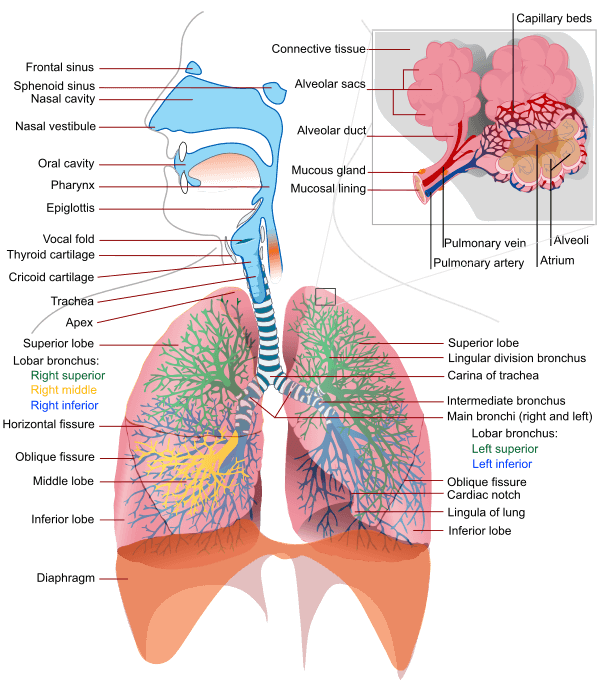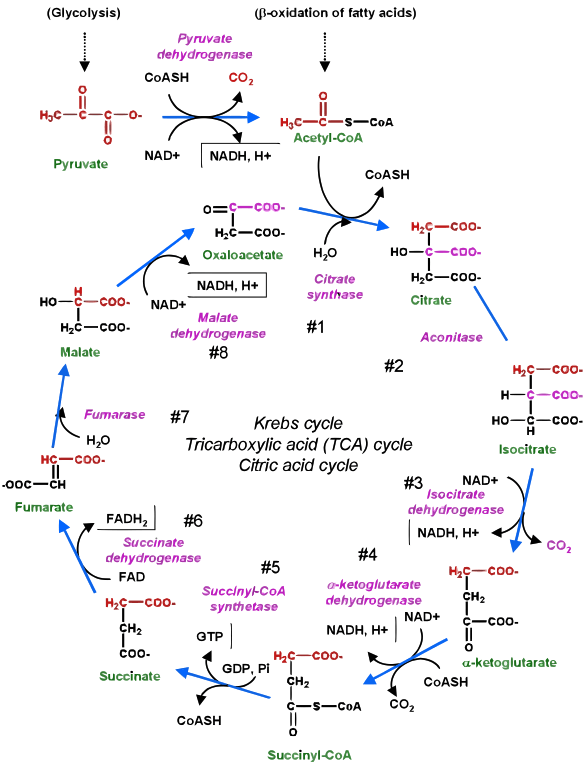Respiratory System: Take a Deep Breath Before Reading
Table of Contents
Depending on how they are categorized, there are about a dozen different major systems in the human body. All of them have an important role to play in keeping you alive and healthy. As the name implies, the respiratory system is responsible for respiration. Its major role is to bring oxygen into the body and for all the cells to use that oxygen efficiently enough to sustain life. This might sound simple, but if you study the respiratory system you will see that it really is quite amazing at what it can do. The respiratory system relies on other systems within the body particularly the circulatory system to be effective.
 The Respiratory System
The Respiratory SystemMechanical Respiration
It all begins with the air in our atmosphere. Sometimes we refer to this as oxygen, but in fact only about 21% of the air around us is made of oxygen. Most of it is made up of nitrogen (78%). The other 1% is water vapor, carbon dioxide, and a few other components of in miniscule amounts. Of course, for most life on Earth oxygen is the most important compound and without it we would be unable to create the energy to power our cells and organs.
As your diaphragm and intercostal (rib cage) muscles contract, a vacuum is created inside your chest. This forces the lungs to expand which pulls in air from the atmosphere. The air passes through the mouth/nose, trachea, bronchioles, and then down to the alveoli in the lungs.
The alveoli are tiny small sacks with very thin wall membranes. They are surrounded by a large number of blood vessels, also with thin walls. This is where the oxygen moves from the alveoli and into the small capillaries. At the same time, carbon dioxide moves from the small capillaries into the alveoli, where it is expelled with the next exhalation breath.
There are about 700 million alveoli in a pair of human lungs. They are extremely elastic, needing to inflate and deflate with each breath. In cases of disease, such as emphysema, the elasticity is lost and stale air becomes trapped in the sacks.
The exchange of oxygen / carbon dioxide occurs through a process called diffusion. This is where something of high concentration moves to an area of low concentration. For example, when your home is too hot, but outside it is cold, and you open a window, the hot air escapes, because the hot air is at a higher concentration than the hot air outside. Of course not all of the hot air escapes, only to the point where they become equal. Similarly, not all of the oxygen will be diffused into the capillaries and not all of the carbon dioxide will be diffused into the alveoli.
Once the oxygen is absorbed into the capillaries the circulatory system will carry the oxygen in the blood to the heart. From there, it is pumped forcefully through the entire body. As these blood vessels travel through the body they branch out into smaller and smaller blood vessels and capillaries.
At some point these tiny capillaries will give the oxygen they are carrying to, for example, a kidney cell. That kidney cell will use the oxygen molecules for metabolism. At the same time, the kidney cell will pass on carbon dioxide to the capillary where it will be taken back to the lungs to be expelled into the atmosphere.
 Kreb's Cycle
Kreb's CycleCellular Respiration
This process takes place down at the cellular level, once the oxygen molecule has entered the cell. You can spend a lot of time studying just this area of physiology, but here are the basics.
Your cells must use energy they obtain from food sources, fats, proteins, and carbohydrates, and in combination with oxygen, produce something called adenosine triphosphate, often just referred to as ATP. This is a catabolic reaction (breaking down) of molecules which results in the release of energy.
There are four aerobic (oxygen using) methods, or cycles, in which your body uses in order to obtain ATP:
- Glycolysis
- Oxidative Decarboxylation of Pyruvate
- Citric Acid (Also called Kreb's Cycle or Tricarboxylic Acid Cycle)
- Oxidative Phosphorylation
Fun Facts
- Breathing is an automatic process, you do it without thinking. However, for a short period of time, you are able to hold your breath, speed up, or slow down your breathing rate.
- On average, at rest, you take about 14 breaths per minute. A baby might take 20 or more breaths per minute.
- The oxygen you expel from your lungs still has about 16% oxygen. Meaning, you only absorb about 5% of it with each breath.
- Breathing too quickly, when the oxygen demand is low, will cause you to hyperventilate and possibly pass out.
- At high altitudes, where oxygen is ‘thinner' the body can adapt to absorb more oxygen with each breath.
- As you hold your breath it is the rise in carbon dioxide, not the lack of oxygen, that tells your brain to force you to breathe.
- The average person can hold their breath for about one minute. Someone well trained can hold their breath for several minutes.
- Freediving is a sport where a diver will attempt to go deep into the water and hold their breath throughout the dive i.e. no scuba gear.



Leave a Reply